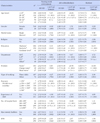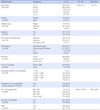Abstract
Purpose
The aim of this study was to investigate and identify work environment, job embeddedness, and burnout among general hospital nurses in Korea.
Methods
The participants were 563 clinical nurses working in 13 general hospitals across the country. Data were analyzed using SPSS and Microsoft Excel programs.
Results
Mean scores were 2.62 for nurses' work environment, 2.97 for job embeddedness, and 3.61 for burnout. Nurses' work environment showed a positive correlation with job embeddedness (r=.70, p<.001), but a negative correlation with burnout (r=-.49, p<.001). Subcategories of nurses' work environment that predicted job embeddedness included satisfaction and happiness, hospital support for the work environment, patient care environment, satisfaction with work schedule, manager leadership, supportive environment for nurses' work, and computer problems. Subcategories of nurses' work environment that predicted burnout included satisfaction and happiness, violence within ward, hospital support for work environment, and patient care environment.
Figures and Tables
Table 3
Perceived Differences in Nurses' Work Environment, Job Embeddedness, and Burnout according to Participant Characteristics (N=563)

References
1. Aiken LH, Havens DS, Sloane DM. The magnet nursing services recognition program: A comparison of two groups of magnet hospitals. Am J Nurs. 2000; 100(3):26–35.
2. Cho SY. Child care teacher's job satisfaction and burnout. J Korean Living Sci Assoc. 2005; 14:69–79.
3. Chun WB, Park IK. Effects of job embeddedness on turnover intention organizational commitment for hotel employees. Tourism Res. 2005; 21:291–308.
4. Duddle M, Boughton M. Development and psychometric testing of the Nursing Workplace Relational Environment Scale (NWRES). J Clin Nurs. 2009; 18:902–909. http://dx.doi.org/10.1111/j.1365-2702.2008.02368.x.
5. Gormley DK. Are we on the same page? Staff nurse and manager perceptions of work environment, quality of care and anticipated nurse turnover. J Nurs Manag. 2011; 19:33–40. http://dx.doi.org/10.1111/j.1365-2834.2010.01163.x.
6. Haynes VD. What nurses want. 2008. 09. 13. Retrieved October 14, 2012. from http://www.washingtonpost.com/wp-dyn/content/article/2008/09/12/AR2008091203367.html.
7. Holtom BC, O'Neill BS. Job embeddedness: A theoretical foundation for developing a comprehensive nurseretention plan. J Nurs Adm. 2004; 34:216–227.
8. Hwang IH, Lee YH. Influences of police officer's job stress and traumatic stress in burnout. Korean J Psychol Gen. 2012; 31:1115–1138.
9. Jang SJ. Relationship between experience of patients' violent behaviors and burnout of psychiatric nurses. Seoul, Korea: Seoul National University;2004. Unpublished master's thesis.
10. Kang KN. Nurses' practice environment, nursing professionalism, career commitment, and turnover intention in the small-medium sized hospital. Seoul, Korea: Ewha Womans University;2010. Unpublished master's thesis.
11. Kim JH. The effects of job embeddedness on turnover intention and organizational citizenship behavior in hospital employee-focusing on moderating effect of personality traits. Busan, Korea: Kyungsung University;2010. Unpublished doctoral dissertation.
12. Kim JK, Kim SY, Yu M, Kim MJ, Lee KA. Korean work environment scales for clinical nurses (KWESCN). Jpn J Nurs Sci. (in press).
13. Kim SH. A study of the influence of job embeddedness on the turnover intention. Seoul, Korea: Hanyang University;2008. Unpublished master's thesis.
14. Kim SP, Lee JS, Choi YM. A study of the influence of job-embeddedness conceived by event workers on turnover intention. J Aviat Manage Soc Korea. 2008; 6(1):27–44.
15. Ko HJ. Nurse work environments, job satisfaction and intention to leave among nurses in a general hospital. Seoul, Korea: Hanyang University;2010. Unpublished master's thesis.
16. Kuehn MB. Creating a healthy work environment for nursing faculty. Creat Nurs. 2010; 16:193–197. http://dx.doi.org/10.1891/1078-4535.16.4.193.
17. Kwon JO, Kim EY. Impact of unit-level nurse practice environment on nurse turnover intention in the small and medium sized hospitals. J Korean Acad Nurs Adm. 2012; 18:414–423. http://dx.doi.org/10.11111/jkana.2012.18.4.414.
18. Lake ET, Friese CR. Variations in nursing practice environments: Relation to staffing and hospital characteristics. Nurs Res. 2006; 55:1–9.
19. Lee KL. The study on decision factor of voluntary turnover: Based on job embeddedness and turnover convenience. Seoul, Korea: Sogang University;2002. Unpublished master's thesis.
20. Lim SJ, Kim HS. Effects of self-efficacy, perceived- fit, and intrinsic motivation on burnout of sexual counsel office staff. Korean J Woman Psychol. 2011; 16:461–475.
21. Maslach C. The burnout syndrome. New York: Prentice Hall;1982.
22. Maslach C, Jackson SE, Leiter MP. Maslach burnout inventory manual. PaloAlto: Consulting Psychologists Press;1996.
23. Mitchell TR, Holtom B, Lee TW, Erez M. Why people stay: Using job embeddedness to predict voluntary turnover. Acad Manage J. 2001; 44:1102–1121. http://dx.doi.org/10.2307/3069391.
24. Park HI, Nam SK, Yang EJ. Relationships of burnout with job attitudes and turnover intention among Koreans: A meta-analysis. Korean J Ind Organ Psychol. 2011; 24:457–491.
25. Park IK. A study on the effects of job embeddedness on turnover intention for hotel employee-the moderating effect of pay satisfaction. Korean J Tourism Res. 2010; 25(3):61–79.
26. Park KK, Lee KE. A study on relationship between job embeddedness and turnover intention in Korea. Korean Manage Rev. 2004; 33:1423–1440.
27. Park KW. The system and policy related to nursing personnel program. Korean J Nurs Query. 2006; 15(2):5–17.
28. Tang WY. A study on the effects of job embeddedness on turnover intention and organizational citizenship behavior. Daejeon, Korea: Chungnam National University;2008. Unpublished master's thesis.
29. Westerman JW, Simmons BL. The effects of work environment on the personality-performance relationship: An exploratory study. J Manag Issue. 2007; 19:288–305.
30. Yang YK. A study on burnout, emotional labor, and self-efficacy in nurses. J Korean Acad Nurs Adm. 2011; 17:423–431.




 PDF
PDF ePub
ePub Citation
Citation Print
Print






 XML Download
XML Download